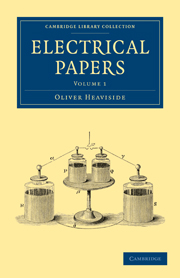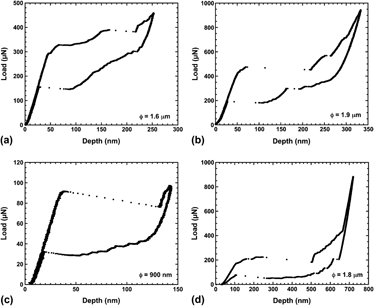Refine search
Actions for selected content:
106102 results in Materials Science
Properties of laser fabricated nanostructured Cu/diamond-like carbon composite
-
- Journal:
- Journal of Materials Research / Volume 26 / Issue 21 / 14 November 2011
- Published online by Cambridge University Press:
- 17 October 2011, pp. 2761-2771
- Print publication:
- 14 November 2011
-
- Article
- Export citation
Plasticity-induced oxidation reactivity on Ni(100) studied by scanning tunneling spectroscopy
-
- Journal:
- MRS Communications / Volume 2 / Issue 1 / March 2012
- Published online by Cambridge University Press:
- 14 October 2011, pp. 23-27
- Print publication:
- March 2012
-
- Article
- Export citation
Grain structure effect on electromigration reliability of Cu interconnects with CoWP capping
-
- Journal:
- Journal of Materials Research / Volume 26 / Issue 21 / 14 November 2011
- Published online by Cambridge University Press:
- 11 October 2011, pp. 2757-2760
- Print publication:
- 14 November 2011
-
- Article
- Export citation
Effect of microstructural heterogeneity on the mechanical behavior of nanocrystalline metal films
-
- Journal:
- Journal of Materials Research / Volume 26 / Issue 22 / 28 November 2011
- Published online by Cambridge University Press:
- 11 October 2011, pp. 2826-2832
- Print publication:
- 28 November 2011
-
- Article
- Export citation
Expanded graphite/cobalt ferrite/polyaniline ternary composites: Fabrication, properties, and potential applications
-
- Journal:
- Journal of Materials Research / Volume 26 / Issue 21 / 14 November 2011
- Published online by Cambridge University Press:
- 11 October 2011, pp. 2683-2690
- Print publication:
- 14 November 2011
-
- Article
- Export citation
Deformation and fracture of single-crystal silicon theta-like specimens
-
- Journal:
- Journal of Materials Research / Volume 26 / Issue 20 / 28 October 2011
- Published online by Cambridge University Press:
- 11 October 2011, pp. 2575-2589
- Print publication:
- 28 October 2011
-
- Article
- Export citation
JMR volume 26 issue 19 Cover and Front matter
-
- Journal:
- Journal of Materials Research / Volume 26 / Issue 19 / 14 October 2011
- Published online by Cambridge University Press:
- 10 October 2011, pp. f1-f5
- Print publication:
- 14 October 2011
-
- Article
-
- You have access
- Export citation
Reactive epoxies with functional zeolite fillers: IR spectroscopy and PALS studies
-
- Journal:
- Journal of Materials Research / Volume 26 / Issue 22 / 28 November 2011
- Published online by Cambridge University Press:
- 10 October 2011, pp. 2877-2886
- Print publication:
- 28 November 2011
-
- Article
- Export citation
NaA zeolite synthesis from geopolymer precursor
-
- Journal:
- MRS Communications / Volume 1 / Issue 1 / November 2011
- Published online by Cambridge University Press:
- 10 October 2011, pp. 49-51
- Print publication:
- November 2011
-
- Article
- Export citation
JMR volume 26 issue 19 Cover and Back matter
-
- Journal:
- Journal of Materials Research / Volume 26 / Issue 19 / 14 October 2011
- Published online by Cambridge University Press:
- 10 October 2011, pp. b1-b5
- Print publication:
- 14 October 2011
-
- Article
-
- You have access
- Export citation
Thermomechanical behavior at the nanoscale and size effects in shape memory alloys
-
- Journal:
- Journal of Materials Research / Volume 26 / Issue 19 / 14 October 2011
- Published online by Cambridge University Press:
- 10 October 2011, pp. 2461-2469
- Print publication:
- 14 October 2011
-
- Article
-
- You have access
- HTML
- Export citation
In situ observation of contact mechanisms in bioinspired adhesives at high magnification
-
- Journal:
- MRS Communications / Volume 1 / Issue 1 / November 2011
- Published online by Cambridge University Press:
- 10 October 2011, pp. 53-56
- Print publication:
- November 2011
-
- Article
- Export citation
Scratch resistance of Al/SiC metal/ceramic nanolaminates
-
- Journal:
- Journal of Materials Research / Volume 27 / Issue 1 / 14 January 2012
- Published online by Cambridge University Press:
- 10 October 2011, pp. 278-283
- Print publication:
- 14 January 2012
-
- Article
- Export citation

Electrical Papers
-
- Published online:
- 07 October 2011
- Print publication:
- 16 June 2011
- First published in:
- 1892
The mechanical properties of bamboo and vascular bundles
-
- Journal:
- Journal of Materials Research / Volume 26 / Issue 21 / 14 November 2011
- Published online by Cambridge University Press:
- 06 October 2011, pp. 2749-2756
- Print publication:
- 14 November 2011
-
- Article
- Export citation
Solution synthesis and novel magnetic properties of ball-chain iron nanofibers
-
- Journal:
- Journal of Materials Research / Volume 26 / Issue 20 / 28 October 2011
- Published online by Cambridge University Press:
- 03 October 2011, pp. 2590-2598
- Print publication:
- 28 October 2011
-
- Article
- Export citation
Mechanism of vertical Ge nanowire nucleation on Si (111) during subeutectic annealing and growth
-
- Journal:
- Journal of Materials Research / Volume 26 / Issue 21 / 14 November 2011
- Published online by Cambridge University Press:
- 03 October 2011, pp. 2744-2748
- Print publication:
- 14 November 2011
-
- Article
- Export citation
CAREER CENTRAL
-
- Journal:
- MRS Bulletin / Volume 36 / Issue 10 / October 2011
- Published online by Cambridge University Press:
- 20 October 2011, pp. 817-823
- Print publication:
- October 2011
-
- Article
-
- You have access
- Export citation
Peter F. Green named inaugural editor-in-chief of MRS Communications
-
- Journal:
- MRS Bulletin / Volume 36 / Issue 10 / October 2011
- Published online by Cambridge University Press:
- 20 October 2011, p. 815
- Print publication:
- October 2011
-
- Article
-
- You have access
- HTML
- Export citation
A. Paul Alivisatos to receive 2011 Von Hippel Award for colloidal nanoparticles
-
- Journal:
- MRS Bulletin / Volume 36 / Issue 10 / October 2011
- Published online by Cambridge University Press:
- 20 October 2011, pp. 811-812
- Print publication:
- October 2011
-
- Article
-
- You have access
- HTML
- Export citation














